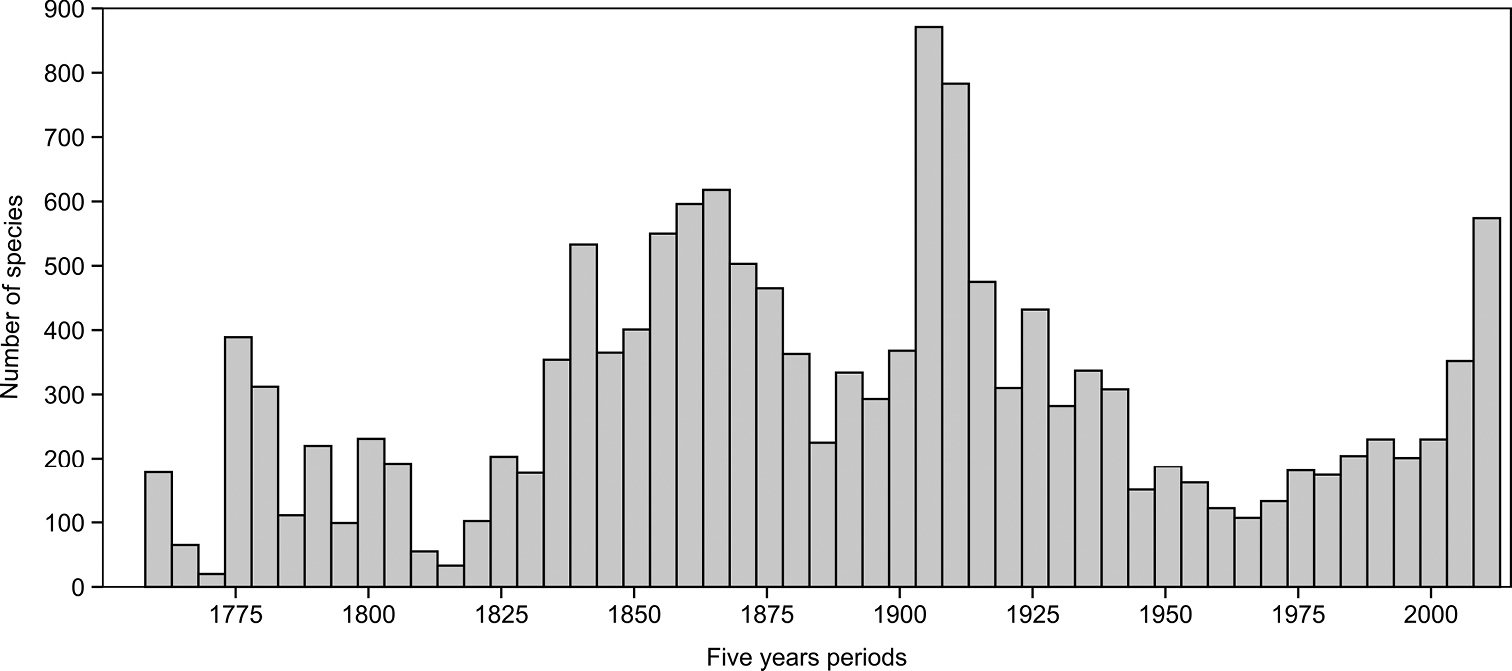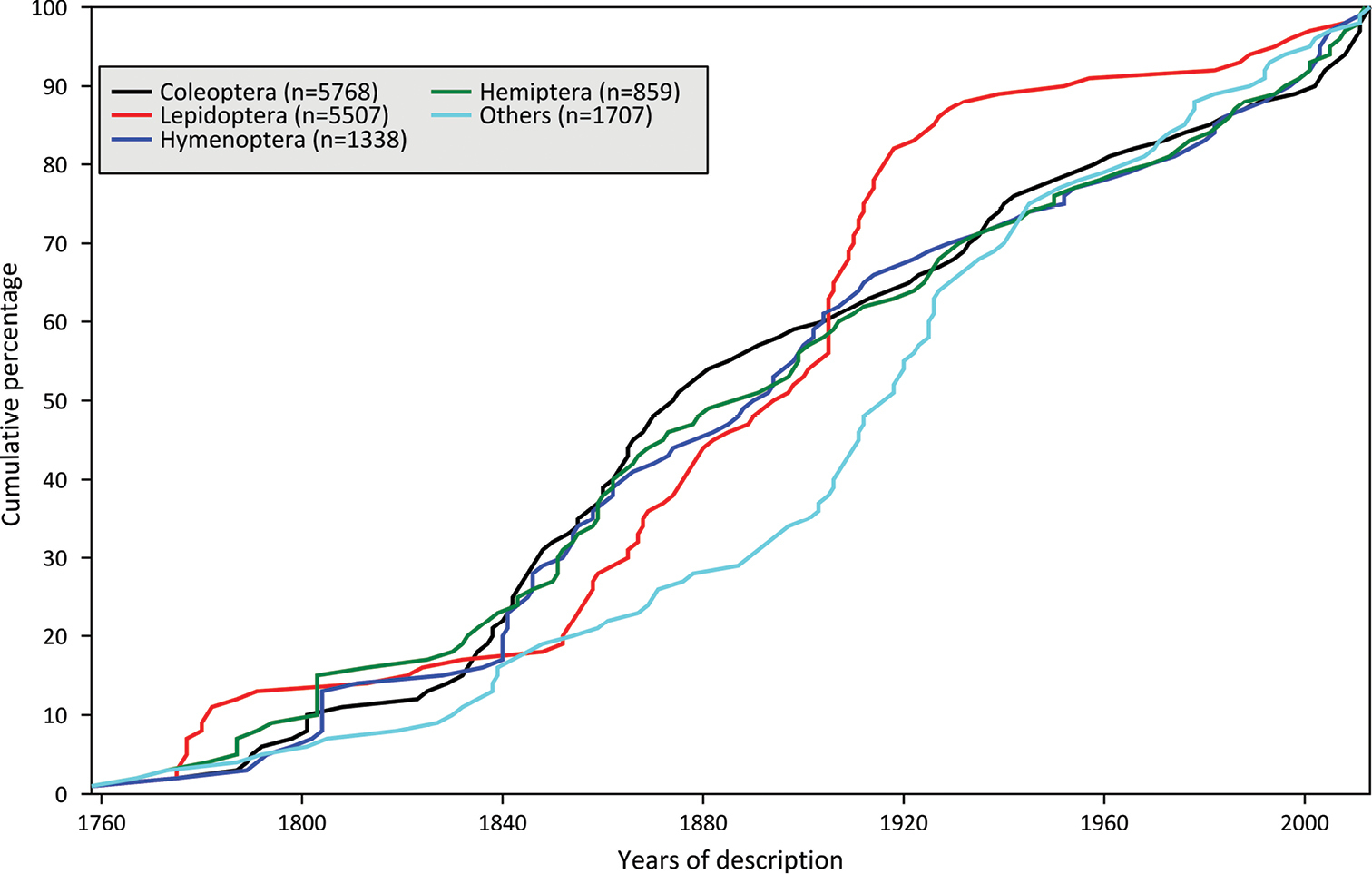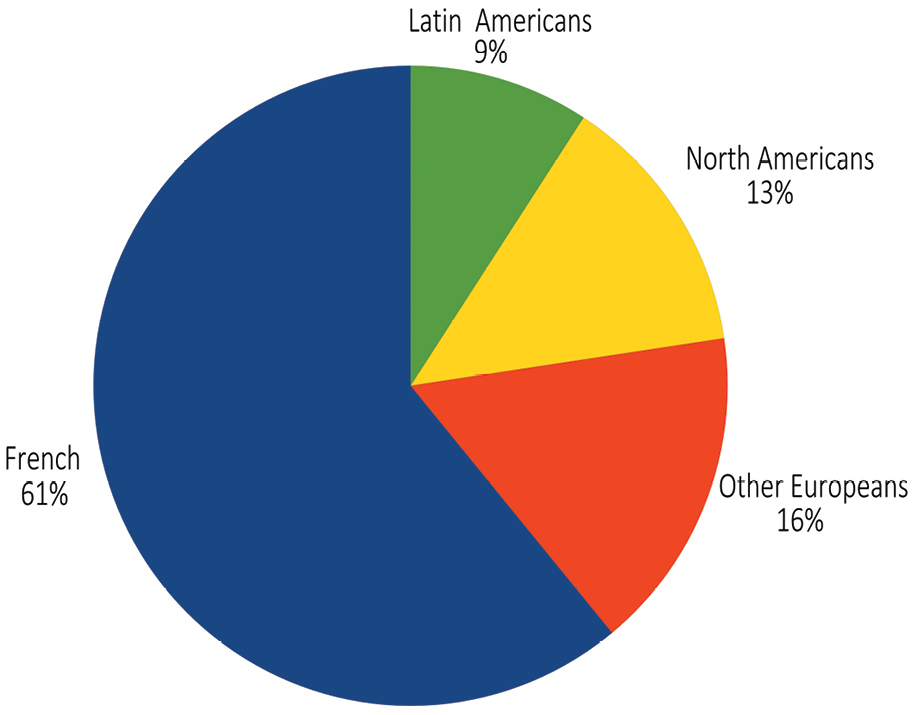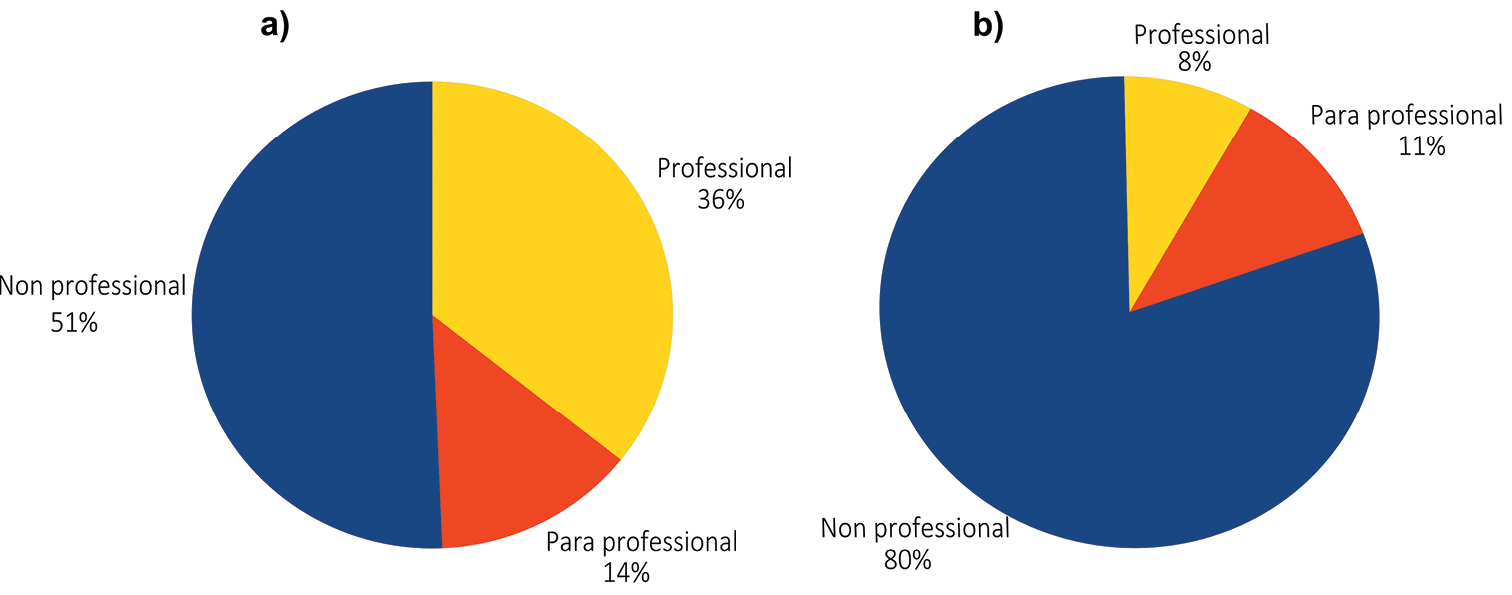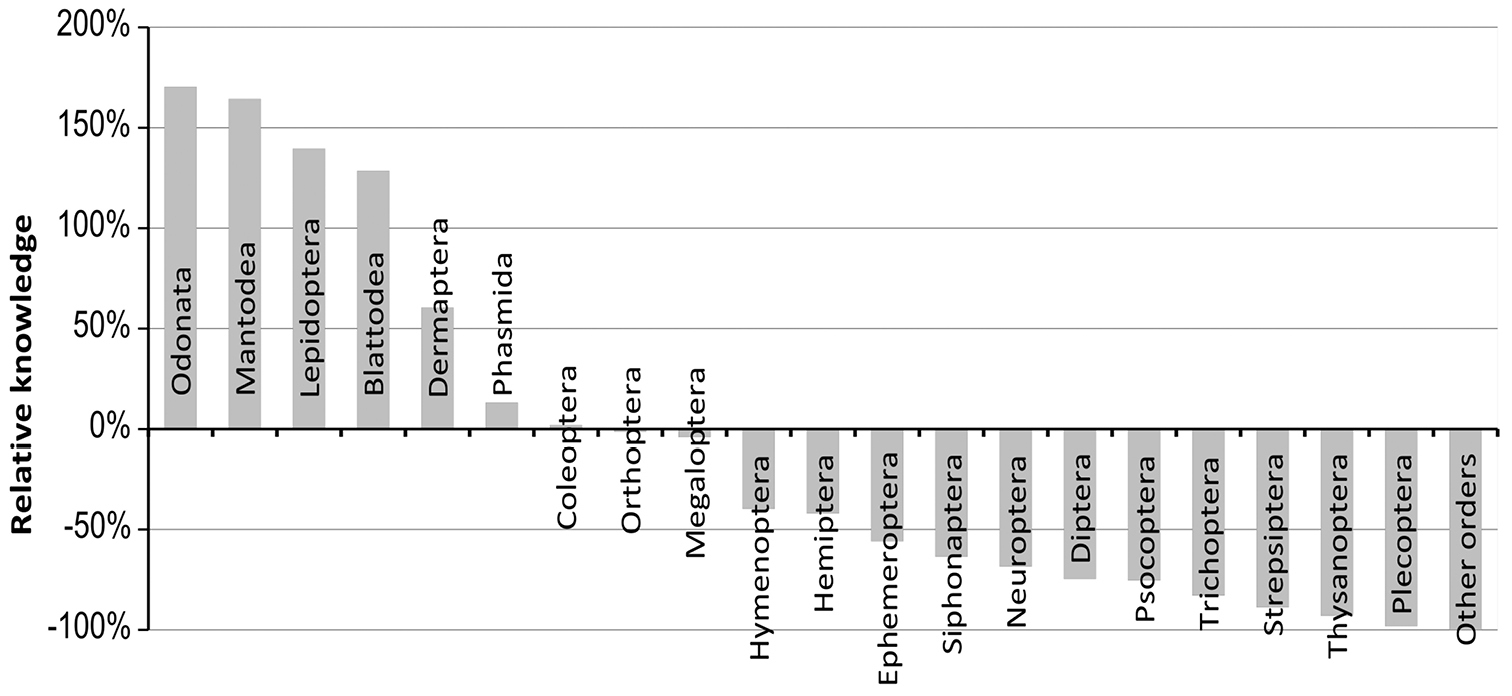






Citation: Brûlé S, Touroult J (2014) Insects of French Guiana: a baseline for diversity and taxonomic effort. ZooKeys 434: 111–130. doi: 10.3897/zookeys.434.7582
This paper analyzes the first checklist of insects from French Guiana. Compiled by a group of 70 experts based on published records, it comprises about 15 100 valid species names belonging to 20 orders and 322 families. Currently, about 17% of the species are only known from French Guiana or from the Guiana Shield region. Since Linné, the average rate of description has been 59 species per year, which has been increasing in the last 10 years. Based on a sample of recent taxonomic and faunistic papers covering 736 new species for French Guiana, 46% of the species came from new country records, the rest from new species descriptions. The rate of faunistic progress (new species or new records) is about 180 species per year over the last five years. Sixty-five percent of these faunal records came from non-professional entomologists and 74% of the holotypes of new species were collected by amateur entomologists. A rough extrapolation, using two different methods, provides a likely estimate of around 100 000 species, the most conservative estimate being 67 000 species and the highest 184 000. Therefore, an estimated 80% of the species remain to be recorded and, in a best-case scenario, at least 270 years would be needed to complete the biotic inventory, at the current rate of species descriptions and distribution records. Although no order is exhaustively inventoried, the most in need of study are Diptera, Hymenoptera, Hemiptera and Trichoptera; and in absolute numbers, Coleoptera. These results and the fundamental role of non-professional entomologists in collecting and describing new species are discussed.
Regional checklist, Neotropics, species database, Guiana Shield, biodiversity, arthropods, taxonomic diversity, endemism, taxonomic effort, Linnean shortfall
The total number of arthropod species in tropical forests has been the object of intense speculation and scientific debate since the extrapolation published by
French Guiana is a small territory of 84 000 km2 in northern South America. It is in the Guianan moist forest ecoregion (
There are at least three important objectives for this work on the compilation of regional species databases:
1) To enable data exchange, which makes data sharing possible between observational or collection databases from different users, as long as they use the same taxonomic list. This data sharing is the basis for filling the “Wallacean shortfall”, which aims to study distribution, biogeographic questions and applied questions of conservation (
2) To have global indicators of diversity and to monitor taxonomic progress, which facilitates communication with the general public and the biodiversity policy makers about invertebrate biodiversity and the challenge of the “Linnean shortfall”, that is to say that only fraction of the planet's species has been described by science (
3) To facilitate the work of taxonomists, by enabling them to easily check what is already known and to stimulate further taxonomic research and the publication of new country records.
For these reasons, we launched this project as a part of the national taxonomic database (TAXREF:
Except for a few families that recently benefited from a regional checklist (e.g.
The lists were compiled in a spreadsheet with the taxonomic hierarchy of family, subfamily, tribe (occasionally), genus, species, subspecies (occasionally), and author's name for each taxon. For this first effort, we focused only on valid taxa. These lists were coded using the TAXREF format (
To compare and extrapolate the total diversity of French Guiana, we first sought published checklists or available online databases for very well-known fauna, in all orders and families, in as close a biogeographical context (tropical America) as possible. We found no convincing resources corresponding to these criteria. We finally used for comparison three faunal references: total species richness of the global, Nearctic and French faunas.
The total number of known species per order worldwide (
The figures for the North American fauna from the Nomina Insecta Nearctica series (
The Fauna Europeae project is a continent-wide data basing effort (
We use a method similar to the one use by
First, experts were asked to provide their best estimate of total number of species, by counting the number of unnamed « sp. » and by extrapolating the number of unseen species. Three estimates were calculated: the minimum, probable « best guess » and maximum number of species. The minimal number is a conservative figure, corresponding roughly to the number of different morphospecies seen from French Guiana by the expert, generally from a huge sample of localities and specimens. In a few cases (5 out of 68) the probable number extrapolates the unseen species from the number of singletons and doubletons as in Chao 1 estimator (
Secondly, we compiled figures of species richness for the same taxonomic groups in benchmark faunas of North America (based on
Thirdly, considering that the proportion of these 68 groups studied was representative of the ratio of richness between French Guiana and the benchmark fauna, we used a simple rule of proportionality to obtain rough estimates of the total diversity of species in French Guiana. For instance, consider that 1 000 species is the estimated total number of species in 10 well-known taxonomic groups in French Guiana; 500 is the reported number of species in the benchmark fauna for those same 10 groups and 100 000 species is the overall number of insect species in the benchmark well-known fauna, then the total extrapolation for French Guiana would be 200 000 species [(1000/500) × 100 000].
As there is no perfect method to assess species richness (
Belonging to the large Guianan moist forest ecoregion, French Guiana shares a species pool with adjacent countries. Species cited from French Guiana can either be described from French Guiana or from another country and then published as a new record for French Guiana. These new country records may be important to assess the real progress of faunistic knowledge. Therefore, we investigate a large sample of 144 faunistic and taxonomic papers dealing with French Guiana, from 2008 to 2013. For each of these, we compute the following items: number of new species and new country records, professional status and nationality of authors and professional status of the collector of the holotype and of all the material cited from French Guiana. To assess how many species were described or cited by status of the authors, we divide the number of species treated by the number of authors (see
Of the 29 orders of insects currently recognized, excluding fossils (
Overall number of taxa known by order in French Guiana.
| Order | Subspecies | Species | Genera | Tribe | Subfamily | Family | Total |
|---|---|---|---|---|---|---|---|
| Blattodea | 251 | 116 | 24 | 8 | 399 | ||
| Coleoptera | 66 | 5759 | 1863 | 343 | 167 | 81 | 8301 |
| Dermaptera | 45 | 21 | 1 | 9 | 3 | 79 | |
| Diptera | 2 | 577 | 142 | 17 | 19 | 32 | 789 |
| Ephemeroptera | 20 | 15 | 1 | 4 | 40 | ||
| Hemiptera | 7 | 859 | 451 | 74 | 78 | 46 | 1515 |
| Hymenoptera | 32 | 1338 | 295 | 67 | 58 | 39 | 1829 |
| Lepidoptera | 561 | 5507 | 1541 | 52 | 91 | 48 | 7800 |
| Mantodea | 93 | 40 | 15 | 14 | 6 | 168 | |
| Megaloptera | 5 | 2 | 1 | 8 | |||
| Neuroptera | 25 | 15 | 1 | 4 | 45 | ||
| Odonata | 13 | 237 | 84 | 14 | 348 | ||
| Orthoptera | 18 | 341 | 216 | 59 | 37 | 12 | 683 |
| Phasmatodea | 50 | 25 | 11 | 8 | 5 | 99 | |
| Plecoptera | 1 | 1 | 1 | 3 | |||
| Psocoptera | 20 | 12 | 9 | 41 | |||
| Siphonaptera | 6 | 12 | 7 | 3 | 28 | ||
| Strepsiptera | 1 | 1 | 1 | 3 | |||
| Thysanoptera | 6 | 6 | 4 | 3 | 19 | ||
| Trichoptera | 36 | 14 | 2 | 6 | 2 | 60 | |
| Total | 705 | 15183 | 4867 | 641 | 517 | 322 | 22257 |
Out of 22 257 taxa listed, about 30% were above the species level. Overall, 15 183 species are inventoried from French Guiana. The compilation and expertise for listing these species may not be comprehensive but the most diverse families are the focus of this work so there should not be too many species missed. At most, we estimate there could be 18 000 published species records from French Guiana.
Only 705 taxa at the subspecies level were mentioned from French Guiana. Lepidoptera accounts for 80% of these taxa, and of these most are Rhopalocera. This is probably due to the focus of entomologists on this well-known suborder.
The fauna of French Guiana is believed to hold few real endemics because, as pointed out for its flora (
Repartition of French Guiana species among different biogeographical categories. “Described from French Guiana” represents taxa known only (so far) from French Guiana.
| Order | Dubious records | Occasional, vagrant | Endemic or sub-endemic | Described from French Guiana | Introduced (not invasive) | Introduced (invasive) | Other “presence” |
|---|---|---|---|---|---|---|---|
| Blattodea | 1 | 0 | 43 | 28 | 0 | 3 | 176 |
| Coleoptera | 78 | 812 | 844 | 5 | 5 | 4021 | |
| Dermaptera | 3 | 42 | |||||
| Diptera | 2 | 6 | 50 | 519 | |||
| Ephemeroptera | 20 | ||||||
| Hemiptera | 30 | 66 | 763 | ||||
| Hymenoptera | 3 | 72 | 132 | 1131 | |||
| Lepidoptera | 11 | 1 | 49 | 265 | 3 | 5178 | |
| Mantodea | 4 | 10 | 79 | ||||
| Megaloptera | 5 | ||||||
| Neuroptera | 25 | ||||||
| Odonata | 2 | 1 | 14 | 2 | 218 | ||
| Orthoptera | 142 | 199 | |||||
| Phasmida | 50 | ||||||
| Plecoptera | 1 | ||||||
| Psocoptera | 20 | ||||||
| Siphonaptera | 12 | ||||||
| Strepsiptera | 1 | ||||||
| Thysanoptera | 6 | ||||||
| Trichoptera | 36 | ||||||
| Total | 97 | 2 | 1033 | 1539 | 8 | 8 | 12502 |
The number of species reported as introduced in French Guiana is very low (16 species, about 0.1%), especially compared with checklists from the West Indies, which categorize about 5% of taxa as introduced (e.g.
The rate of species descriptions is, on average, 59 valid taxa per year being added to the French Guiana fauna during the 255 years between Linné and today (2013). The highest peak was during the early twentieth century, with 178 species per year between 1904 and 1908. In the last century, the lowest period was between 1960 and 1970. In the last five years (2008-2012) the rate is nearly twice this average, with 102 species per year.
Description curves cannot be used for estimating total species richness (
The peak in the early 20th century was due to the publication of books, mainly on Lepidoptera, which yielded numerous new species at the same time, whereas now, new species are typically described in journal articles, which results in many more papers and authors than before, but fewer species per paper (as pointed at the global level by
The overall rate observed in Figures 1 and 2 does not necessarily mean that species were described from French Guiana, but may be due to subsequent new faunal records. In our sample of 144 papers from the last six years, 344 species (47%) were new country records of species previously described from other countries, and 393 (53%) were new species descriptions based totally or partially on material from French Guiana. This implies that, in the last six years, more than 100 new species were described per year, with about the same number of new species records added. The overall rate of species addition may therefore be about 180 species per year, of which ca. 100 are new descriptions, another 90 are new records, minus 10 probable future synonyms.
Number of described species from the French Guiana fauna by five year period from Linné to 2013.
Cumulative rate of description of species belonging to the French Guiana fauna, for the four most diverse orders and for other excluded orders, from Linné to 2013.
Sixty-five percent of new additions to the French Guiana fauna are made by non-professionals (Table 3). There is a significant difference (Chi2=69.6; df=4; p<0.001) between orders. Coleoptera and Lepidoptera are mainly studied by non-professionals, although both are also studied extensively by professional taxonomists. On the other hand, Diptera, Hemiptera and Hymenoptera are mainly studied by professionals. This is likely due to the fact the Lepidoptera and Coleoptera are very popular among collectors, whereas the other orders are traditionally less so.
Number of taxonomic additions (new species or new records) to the French Guiana fauna by author type, for the 144 recent papers reviewed. Other orders (Diptera, Hymenoptera and Hemiptera), are pooled because they exhibit the same pattern.
| Order | Non-professional | Para-professional | Professional |
|---|---|---|---|
| Coleoptera | 407 | 83 | 134 |
| Lepidoptera | 64 | 1 | 8 |
| Other orders | 5 | 8 | 26 |
| Total | 476 | 92 | 169 |
| Proportion | 65% | 13% | 23% |
French entomologists, including those from French Guiana, are, as expected, the most active at describing new species, followed by other Europeans, North Americans and entomologists from South and Central America (Fig. 3). In detail (Fig. 4), non-professionals are describing half of the new species, but are publishing 80% of the new country records. This is probably due to the low academic reward for faunistic records, whereas such records are considered of interest by amateur naturalists making a collection. The intermediate category of “para-professional” can be viewed as a higher level part of the non-professional as, strictly speaking, they are not professional taxonomists. This key role of non-professionals confirms the conclusions about taxonomic work within the European fauna (
Repartition of the 393 new species according to the country of the authors.
Proportion of taxonomic contributions according to the status of the authors. a) descriptions of new species (n= 393) and b) new country records of species described from another country (n=344).
By looking at the sources of the specimens treated in the 144 papers, the importance of amateur entomologists is even more obvious (Fig. 5). Seventy-four percent of the holotype specimens were collected by amateurs. Interestingly, a rather important part of these specimens comes from surveys made by amateurs for protected areas managers. Academic researchers yielded just 14% of the holotypes, few of which come from material collected during ecological studies not targeted at taxonomic discovery. A small but non negligible proportion (5%) of the holotypes came from insect dealers, who made material available for purchase and study.
Origins of the holotypes of a sample of 393 species described from French Guiana between 2008 and 2013.
Concerning French Guiana and contrary to common perceptions about the decline of taxonomy (
Using two well-known insect faunas, the extrapolation of species diversity for French Guiana, based on benchmark taxonomic groups, gives a probable number of species between 100 000 and 120 000, with a conservative estimate of 67 000 species and a highest estimate at 184 000 (Table 4). Estimates using the French fauna as a benchmark are consistently higher than those based on the Nearctic list. The ratio between the richness of the reference fauna and French Guiana is highly variable among groups (Suppl. material 2). Each reference fauna has a bias. The French fauna is quite well-known but belongs to a different continent with a different biogeographical history than French Guiana. For the Nearctic fauna, the 95 000 total species figure of
Total insect diversity estimates for French Guiana. Calculation based on extrapolation of the richness of 68 taxonomic groups (Suppl. material 2) from two well-known temperate reference faunas, North America and France.
| Reference fauna | Minimal estimate for French Guiana | Maximal estimate for French Guiana | Most likely estimate |
|---|---|---|---|
| Nearctic region ( |
67 000 | 156 000 | 101 000 |
| Metropolitan France and Corsica (MNHN 2013): 36 000 species | 81 000 | 184 000 | 116 000 |
The second method for extrapolating species richness, using an arthropod/plant ratio, which was found to be consistent in Panama (
This estimation represents about 10% of the total insect diversity expected in Brazil by
Although current taxonomic effort is higher than the historic average, at this rate, even in the most optimistic scenario (18 000 known species, 67 000 extrapolated species, 180 species added per year), an additional 270 more years would be needed to complete the taxonomic inventory! This is indeed optimistic as the description curve will tend to figau when most of the easier, larger and more attractive groups have been studied (
We compared the richness by order in French Guiana with that expected from the richness compiled at the global level (
Ratio between the number of known and expected species richness in French Guiana. Ratios are based on the number of known species in French Guiana and the number described at the world level (
Five groups appeared to be relatively better studied (and/or possibly more diverse) in French Guiana, compared to the global level: Odonata, Mantodea, Lepidoptera, Blattodea, and to a lesser extent, Dermaptera. Four groups studied are at a comparable level between French Guiana and the world as a whole: Phasmatodea, Coleoptera, Orthoptera and Megaloptera. It should be noted that the known richness of the orders in these two categories is still far from being exhaustive, including Lepidoptera and Odonata (Suppl. material 2). The other 20 orders are underrepresented in the faunal list of French Guiana in comparison to the figures at the world level. They might be either genuinely poorly represented in French Guiana, for large scale biogeographical reasons, or perhaps they have not received as much taxonomic work as other taxa. Considering the rate of description in these groups (Hymenoptera, Hemiptera, and orders excluded, Fig. 2) the second hypothesis is overall more likely than the first. The highly diverse orders, which are obviously understudied in French Guiana, offer the largest opportunity for taxonomic discoveries, descriptions and new country records. The first four are: Diptera, Hymenoptera, Hemiptera and Trichoptera. The megadiverse order Coleoptera, although studied on average the same as at the world level, is certainly, in absolute number, the one where most species remain to be described.
Knowledge of French Guiana’s insect diversity has been progressing at a relatively high rate in the past 10 years, mainly due to efforts of the large amateur community involved in collecting material for study and in taxonomic work. Demand for faunal surveys by protected areas managers has also opened the opportunity to obtain material from remote areas. However, the taxa inventory is far from complete. Even for longhorn beetles (Coleoptera: Cerambycidae), a well-known group in French Guiana, which has long been the focus of intense collecting and taxonomic work from amateurs and professionals, from France, US and Brazil, at least one third of the species remain to be described or revised (1 200 species known, 1 800 species are the lower estimate; Suppl. material 2). If we are to overcome the « Linnean shortfall » and start to fill the « Wallacean shortfall » (
Interestingly, it should be mentioned that French Guiana is among the last countries in South America that has no constraining regulation on collecting insects over the whole territory. With no major impact on insect conservation, this has clearly favored contributions to the description of the fauna from the amateur community, and also the collection of material, including by insect dealers, a part of which has been the basis for many significant taxonomic works.
We consider the building and maintenance of a regional species database for insects as an opportunity to raise awareness of insect diversity and to measure the taxonomic gap. The initial checklist analyzed in this paper will be regularly supplemented and corrected, with updates made available from an online downloadable database (
We wish to thank our friends and colleagues of the SEAG, for hundreds of hours spent on the ground and sorting the samples collected during this study. We also wish to thank all fellow entomologists who compiled species lists and who agreed to receive (or received) and study (or studied) the entomological material and to participate in the various entomological works done in French Guiana, without whom our knowledge would not have increased in recent years: Alexandre Aguiar, Angélico Asenjo, Alberto Ballerio, Max Barclay, Paula Batista dos Santos, Frédéric Bénéluz, Jean-Michel Bérenger, Paul Beuk, Svatopluk Bily, Denis Blanchet, Olivier Boilly, Stéphane Boucher, Volker Brachat, Yves Braet, Harry Brailovksy, Boris Büche, Fabio Cassola, Jacques Chassain, Andrew Cline, Philippe Collet, Oskar Conle, Robert Constantin, Geovan Corrêa, Gianfranco Curletti, Mauro Daccordi, Pierre-Henri Dalens, Nicolas Degallier, Gérard Delvare, Thierry Deuve, Benoit Dodelin, Frédéric Durand, Marc Epstein, Terry Erwin, Christophe Faynel, François Feer, Rodrigo Feitosa, Serge Fernandez, Julio Ferrer, Eric Fisher, Carlos Flechtmann, Antoine Foucard, Alexandre François, Steve Gaimari, David Gibbs, Jessica Gillung, Christophe Girod, David Gonzales, Eric Guilbert, Grey Gustafson, Esteban Guttierez, Martin Hauser, Ernst Heiss, Daniel Herbin, Bernard Hermier, Andreas Herrmann, Gary Hevel, Mary Liz Jameson, Laurent Juillerat, Bruno Kneubühler, Olavi Kurina, Fabrice Lavalette, Gérard Le Goff, Pascal Leblanc, Daniel Lohez, Roland Lupoli, Daiara Manfio, Antoine Mantilleri, Lubomir Masner, Lucia Massutti de Almeida, Erica Mc Alister, Charyn Micheli, Olaf Mielke, Didier Morin, Miguel Angel Moron Rios, Massimo Olmi, Ivan Paulmier, Eddy Poirier, Alain Pauly, Yannig Ponchel, Adrian Pont, Pierre Queney, Chris Raper, Brett Ratcliffe, Joachim Rheinheimer, Menno Reemer, Albino Sakakibara, Floyd Shockley, John Smit, Villu Soon, Marc Soula†, Adeline Soulier-Perkins, Cibele Stramare Ribeiro-Costa, Daniela Takyia, Paul Thiaucourt, Alain Thomas, Marc Thouvenot, Guy Tomasovic, José Fernandez Triana, Marc Tussac, Lars Vilhelmsen, Monty Wood, Franz Wachtel, Jean-Hervé Yvinec and Theo Zeegers. We also thank Richard Houghton, Karine Brûlé, Alan Mudge and Gino Nearns for checking and improving the English language of our paper.
How to access, cite and contribute to the TAXREF species database?
Authors: Stéphane Brûlé, Julien Touroult
Data type: documentation (PDF file)
Explanation note: This file explains who contributed to the species database and give links for downloading the taxonomic database.
Copyright notice: This dataset is made available under the Open Database License (http://opendatacommons.org/licenses/odbl/1.0/). The Open Database License (ODbL) is a license agreement intended to allow users to freely share, modify, and use this Dataset while maintaining this same freedom for others, provided that the original source and author(s) are credited.
Total species richness estimations for 68 taxonomic groups in French Guiana
Authors: Stéphane Brûlé, Julien Touroult
Data type: Spreadsheet (xls file)
Explanation note: Estimated and extrapolated species richness for 68 taxonomic groups in French Guiana and comparative figures for two well-known faunas. These taxa are used to extrapolate the total number of species in French Guiana given in Table 4.
Copyright notice: This dataset is made available under the Open Database License (http://opendatacommons.org/licenses/odbl/1.0/). The Open Database License (ODbL) is a license agreement intended to allow users to freely share, modify, and use this Dataset while maintaining this same freedom for others, provided that the original source and author(s) are credited.
